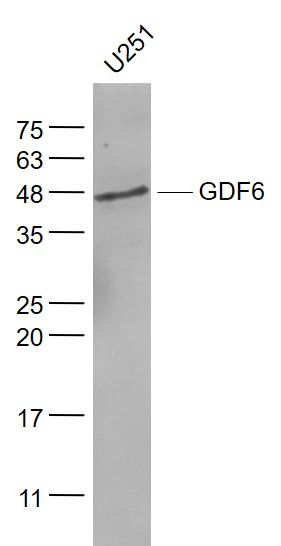产品货号 : mlR11843
英文名称 : GDF6
中文名称 : 生长分化因子6抗体
别 名 : bmp 13; bmp13; bmp-13; Cartilage Derived Morphogenetic Protein 2; cdmp 2; CDMP2; gdf 6; GDF16 ; Growth differentiation factor 6; Growth/differentiation factor 6; GDF6_HUMAN.
研究领域 : 细胞生物 神经生物学 信号转导 生长因子和激素
抗体来源 : Rabbit
克隆类型 : Polyclonal
交叉反应 : Human, Mouse, Rat, Dog, Cow, Horse, Rabbit,
产品应用 : WB=1:500-2000 ELISA=1:500-1000 IHC-P=1:400-800 IHC-F=1:400-800 ICC=1:100-500 IF=1:100-500 (石蜡切片需做抗原修复)
not yet tested in other applications.
optimal dilutions/concentrations should be determined by the end user.
分 子 量 : 14kDa
细胞定位 : 分泌型蛋白
性 状 : Lyophilized or Liquid
浓 度 : 1mg/ml
免 疫 原 : KLH conjugated synthetic peptide derived from human GDF6:336-410/455
亚 型 : IgG
纯化方法 : affinity purified by Protein A
储 存 液 : 0.01M TBS(pH7.4) with 1% BSA, 0.03% Proclin300 and 50% Glycerol.
保存条件 : Store at -20 °C for one year. Avoid repeated freeze/thaw cycles. The lyophilized antibody is stable at room temperature for at least one month and for greater than a year when kept at -20°C. When reconstituted in sterile pH 7.4 0.01M PBS or diluent of antibody the antibody is stable for at least two weeks at 2-4 °C.
PubMed : PubMed
产品介绍 : Growth/differentiation factors (GDFs) are members of the TGF superfamily (1,2). Members of the TGF superfamily are involved in embryonic development and adult tissue homeostasis (1). GDF-1 expression is almost exclusively restricted to the central nervous system and mediates cell differentiation events during embryonic development (3). Neither GDF-3 (Vgr-2) nor GDF-9 contains the conserved cysteine residue which is found in most other TGF superfamily members. GDF-3 is detectable in bone marrow, spleen, thymus and adipose tissue, whereas GDF-9 has only been detected in ovary (4). GDF-5 (also designated CDMP-1) has been shown to induce activation of plasminogen activator, thereby inducing angiogenesis. It is predominantly expressed in long bones during fetal embryonic development and is involved in bone formation. (5). GDF-5 mutations have been identified in mice with the mutation brachypodism (bp), a mutation which affects the length and number of bones in limbs (6). GDF-6 and GDF-7 are closely related to GDF-5 (6). GDF-8 has been shown to be a negative regulator of skeletal muscle mass (1).
Function:
GDF6 (Growth/differentiation factor 6) is expressed in hypertrophic chondrocytes during embryonic development of long bones and is required for normal formation of bones and joints in the limbs, skull, and axial skeleton. It plays a key role in establishing boundaries between skeletal elements during development. The functional form of GDF6 is a disulfide-linked homodimer of two 120 amino acid polypeptide chains obtained by proteolytic processing of a biologically inactive precursor protein.
Subunit:
Homodimer; disulfide-linked
Subcellular Location:
Secreted
DISEASE:
Defects in GDF6 are the cause of Klippel-Feil syndrome type 1 (KFS1) [MIM:118100]. A skeletal disorder characterized by congenital fusion of cervical vertebrae. It is due to a failure in the normal segmentation of vertebrae during the early weeks of fetal development. The clinical triad consists of short neck, low posterior hairline, and limited neck movement. Deafness is a well-known feature of KFS and may be of sensorineural, conductive, or mixed type.
Note=A chromosomal aberration involving GDF6 has been found in a patient with Klippel-Feil syndrome (KFS). Paracentric inv(8)(q22;2q23.3).
Defects in GDF6 are the cause of microphthalmia isolated type 4 (MCOP4) [MIM:613094]. A disorder of eye formation, ranging from small size of a single eye to complete bilateral absence of ocular tissues. Ocular abnormalities like opacities of the cornea and lens, scaring of the retina and choroid, cataract and other abnormalities like cataract may also be present.
Similarity:
Belongs to the TGF-beta family.
SWISS:
Q6KF10
Gene ID:
392255
Important Note:
This product as supplied is intended for research use only, not for use in human, therapeutic or diagnostic applications.
产品图片












